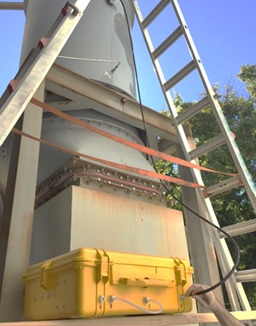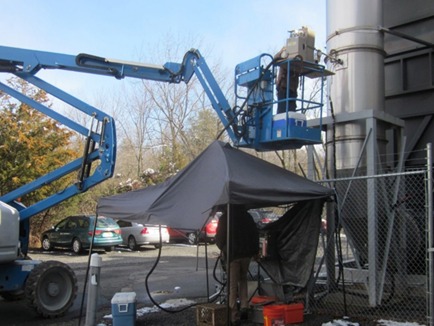In this age of viral tweets, your firm’s reputation is constantly up for debate, making brand management crucial. While financial risk from lack of compliance is a familiar threat to your brand and bottom line alike, the issue of odors emanating from your manufacturing facilities may not be as common. Now that unhappy community members can so easily and quickly take to social media, managing odors has emerged as a reputational and business risk for environmental health & safety (EHS) and corporate managers to keep top of mind.
With increased globalization and automation, today’s manufacturing facilities employ fewer people than in the past and may have a less direct connection with the surrounding population. This has resulted in manufacturing facilities being less central to local communities and residents less likely to feel a sense of loyalty. You don’t want a nuisance odor to be the first time a community becomes aware of your company. If word spreads across Facebook – despite how credible or not the claim may be – your brand could take a hit. This could mean decreased sales or operating downtime while you locate the source of the odor and mitigate the issue.
To compound the problem, few state regulatory agencies have codified numeric thresholds for odors, but most have a vague, undefined nuisance odor regulation. This means that manufacturers must address odors subjectively perceived by community members to be a nuisance, even though their facilities already meet local or state air quality compliance.
There are various methods that can mitigate manufacturing odors, as well as calm community sentiments and protect your brand reputation. But many can involve costly technology purchases that would hurt the bottom line and may not resolve all community concerns. To minimize the business risks associated with a concerned and organized community, a company facing odor complaints will need to not only find a cost-effective solution but also work with the community, local government, and state regulators to support it. Read on to learn about one firm that faced this challenge.
Case study: A manufacturer’s odor challenge
Haley & Aldrich’s EHS experts have worked with manufacturers dealing with community odor concerns that had been elevated to government agencies. In this example, the manufacturer didn’t know for sure if the off-site odors were indeed emanating from their facility but were facing fines for violating state nuisance odor regulations. They also weren’t sure why their control devices weren’t working, and if the odors persisted, they would have had to stop making certain products to eliminate the issue.

The company was seeking a solution that would allow them to maintain manufacturing operations and avoid the potential loss of business to competitors. They also needed to navigate state agency negotiations, preserve the company’s relationship with the community, and minimize the financial impact of any fines and production losses – all of which would ultimately protect the brand.
To counter the complex, subjective nature of this odor challenge, Haley & Aldrich’s air quality specialists made sure to take a wide view, understanding that they would not resolve this problem with a purely technical analysis. We understood that any solution we developed needed to meet the needs of not only our client, but also those of the community and regulators.
A strategic approach for resolving odor problems
We used a three-stage process to identify potential sources of odor, evaluate the impact of these odors, and offer odor mitigation recommendations for controlling the issue. Through these steps, we could pinpoint the source of the odor, determine several solutions, and recommend those aligned with our client’s business objectives.
1. Odor assessment
Through our odor assessment study, which included reviewing local meteorological data, we determined that the community odor complaints were directly correlated to when the manufacturer was producing specific products. Our assessment steps included documentation review, personnel interviews, on-site and off-site observations, and external research into the raw materials used by the company.
2. Exposure assessment

At this stage, we evaluated and quantified the odor impacts through sampling and modeling. We confirmed the hypothesis developed during the odor assessment stage – that the facility was indeed the source of the odor. Then, we gathered information to inform control analysis.
Steps to assess exposure included developing a sampling plan, conducting odor sampling, collecting meteorological data, and quantifying odor levels. Using this data, we estimated the possible extent of odor impacts beyond the geographic boundaries of the facility and within the community.
3. Exposure control
Here, we offered recommendations for odor mitigation and control. We first measured the effectiveness of existing control devices through emissions testing. Through engineering analysis, we identified the reasons for their ineffective control, then evaluated the economic and technical feasibility of various mitigation options asking ourselves, “would they work?” and “would they be cost-effective to implement?” From that analysis, we recommended the best odor mitigation and control options and presented these recommendations to senior management.
Based on our work, we recommended, and our client agreed, that the best solution was to install a thermal oxidizer, a process unit that controls air pollution. Essentially, it decomposes gases at a very high temperature (1,400 degrees Fahrenheit) and then releases mostly heat, carbon dioxide, and water vapor. The device can be turned on and off depending on which product was being manufactured, so our client had the flexibility to employ it only during certain manufacturing processes that emitted odors – minimizing the operating cost and emissions of the thermal oxidizer.
We also met with state regulators to present our findings and data to ensure they understood the level of effort our client was employing to identify a solution and mitigate the nuisance odor. By working with our client’s attorney and regulating agencies along the way, we were able to communicate our client’s good faith effort to remove nuisance odor complaints and mitigate compliance risk with regulatory communities.
Mitigating next-level business risk
Our approach ensured our client could comprehensively resolve their odor problem and mitigate the business risk of an angry community. We were able to quantify what had been a subjective problem, identify the source of the odor and the scope of the problem, and recommend a technically and economically feasible solution. This allowed the facility to continue manufacturing products, resulting in a $140,000 savings to our client by eliminating the need for control equipment that they were considering using but which would have proven ineffective. We also helped them avoid spending approximately two years on experimentation to ensure that the proposed control equipment worked properly.
During agency negotiations, we presented the technical results and recommendations that supported the path forward, which resulted in reduced potential fines and improved relations with local and state agencies. Ultimately, the odor solution we uncovered mitigated business risk, allowing our client to keep critical manufacturing operations running, and maintain their good reputation within the community and their strong brand.
Keep production, and your brand, on track

With nearly 4 billion people using social media (or about half of the world) for 144 minutes each day, business risk stemming from damage to brand reputation is becoming more common and just as devastating as more traditional risks such as non-compliance. For manufacturers, one major vulnerability is odors that affect the communities surrounding their facilities. Working with an engineering partner that helps you mitigate this risk in a cost-effective way will ensure your brand maintains its good reputation both within the community and beyond.
Don’t let air quality permitting derail your next project. Learn how our air quality specialists keep the big picture in mind so you can focus on what really matters.
Published: 11/30/2020
Authors

Senior Associate, Chemical Engineer

Service Leader, EHS Compliance



